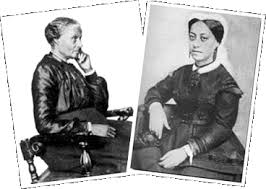
Mary Ellen Pleasant has been called the "Mother of Civil Rights in California" . Long before Rosa Parks, Mary Ellen Pleasant was a famous and rich woman in San Francisco who played a significant role in abolition of slavery, the gold rush and the Civil War. Histories of the west describe her as a madam, a voodoo queen and a prostitute. She was born in 1814 in slavery and was educated in Nantucket and while in Boston began associations with William Lloyd Garrison and other abolitionists including Alexander Smith who she married. After his death she moved west, spending some time in Canada working with fugitive slaves near Chatham in the 1850's. That is when she met John Brown where the raid on Harper's Ferry was planned. Mary Ellen requested that her gravestone be inscribed "she was a friend of John Brown".
In 1852, Mary Ellen came to San Francisco, fleeing prosecution under the Fugitive Slave Act for her work leading people from slavery to freedom. She continued that work in California, sheltering people who escaped slavery and finding employment for them. Pleasant arrived in San Francisco with a considerable sum of money left to her by her first husband. She invested it wisely: Her businesses here included laundries, dairies and exclusive restaurants — all of which were quite lucrative in a city filled with miners and single businessmen. In the 1890 census she listed her occupation as “capitalist.”
Her restaurant attracted prominent men such as Darius Mills, William Ralston and William Sharon — men who made their fortunes in the Comstock lode and who later founded the Bank of California. The young women who worked in the restaurant were told to listen to the dinner conversation and report back the financial gossip of the makers and shakers. Pleasant put the information to use in her own financial investments.
While in San Francisco, she married James Plaisance, with whom she had a daughter. Her family relations were not good; she changed her name and had little contact with her daughter. The great love of her life was Thomas Bell, a Caucasian she met on the ship to San Francisco and who became her business partner and almost certainly her lover. Since her gender and race precluded her from engaging in financial affairs, she made her investments through Bell. Their joint fortune reportedly reached $30 million.
Her 30-room Octavia Street Italianate mansion, which she designed, built and furnished, became known as the Thomas Bell mansion. When she moved in, Bell did too, along with a Caucasian wife Pleasant more or less found for him. Because of this living arrangement, and because of rumors about events and underground passages at the house, it also became known as the “House of Mystery.”
Probably out of envy and anger at the enormous success of a black woman, rumors abounded about Pleasant’s manner of making money. For the same reasons, she was referred to as “Mammy” Pleasant, a name that persists in accounts to this day. She detested the insulting nickname, and returned envelopes addressed that way unopened. And when Thomas Bell died after falling down a flight of stairs, rumors suggested that she was responsible — even after the coroner’s jury found that the death was accidental.
Pleasant was also becoming an activist and civil rights pioneer. She helped hide a slave named George Mitchell, whose owner tried to keep him through California’s 1852 fugitive slave law after bringing him to the state in 1849. In 1858, she hid another slave, Archy Lee, whose owner received permission by the California Supreme Court to take Lee back with him to Mississippi.
Pleasant successfully attacked racial discrimination in San Francisco public conveyances after she and two other black women were ejected from a city streetcar in 1866. She filed two lawsuits. The first, against the Omnibus Railroad Company, was withdrawn after the company promised to allow African-Americans to board their streetcars. The second case, Pleasant v. North Beach & Mission Railroad Company, went to the California Supreme Court and took two years to complete. In the city, the case outlawed segregation in the city's public conveyances. However, at the State Supreme Court, the damages awarded against her at the trial court were reversed and found excessive.
She released an autobiography in 1902, two years prior to her death. The autobiography claimed that she was born in Philadelphia in 1814 to a mother who was a “full-blooded Negress from Louisiana” and a father who was Hawaiian. One of the more notable claims made in the autobiography is that Pleasant helped fund abolitionist John Brown‘s raid on Harpers Ferry in 1859, donating $30,000 — almost $900,000 in today’s dollars — to the cause. Still, news stories and obituaries like the San Francisco Examiner’s “Mammy Pleasant Will Work Weird Spells No More,” as well as the fictional “biography” Mammy Pleasant, written by Helen Holdridge in 1953, further perpetuated the idea of Pleasant as a mammy and voodoo practitioner who amassed her fortune by controlling and manipulating people. The title encapsulated what Pleasant had been reduced to: a black woman believed to have used magic and supernatural powers to amass the influence, money, and power that she did. In reality, the answer is likely more simple — she was like her white counterparts: savvy, smart, and strategic.
Pleasant’s legacy is the embodiment of a black woman having to be mindful of what she chose to distort, omit, or share about her life in order to survive. Of the lack of control black people then — and now — have over how their story gets told, especially in death. Pleasant is more than the folklore and mythos that has defined her for so long. She was a fearless and unconventional black figure who left behind a complex and fascinating legacy, setting a foundation for the black figures who succeeded her.